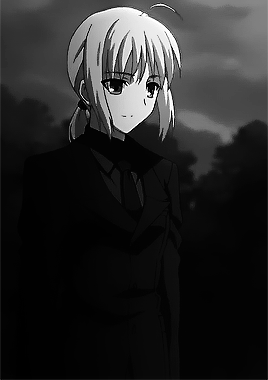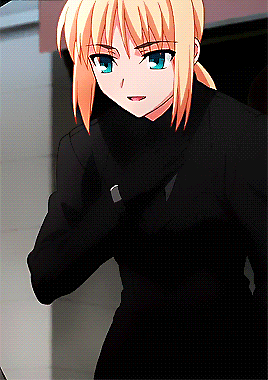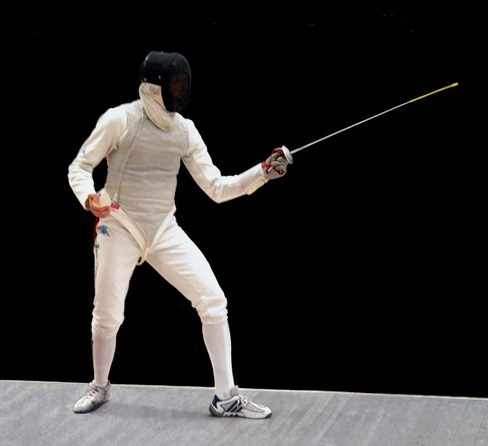#saber gif
Explore tagged Tumblr posts
Text

460 notes
·
View notes
Photo








Saber "Richard I, Lionheart, Wandering King" (セイバー) - Fate/strange Fake - Episode 1
#Fate Strange Fake#Fate Series#fateedit#fategraphics#Saber#Richard I#Lionheart#Wandering King#my gifs#my post#long post
276 notes
·
View notes
Text




— Did I really make an acceptable gentleman escort? — You were absolutely perfect, Saber. You really were the most wonderful knight a girl could ever hope for!
#fate series#fate stay night#fate zero#irisviel von einzbern#saber#artoria pendragon#anime#gifus#what if I end it all Part 2#I love them so much 😭😭#I'm not ready for whatever tragic ending they are getting I'm really not#fate edit#fategraphics#fateedit#idk the tags#saber x iris#saber x irisviel
242 notes
·
View notes
Text
Winter: (Drawing, Humming)
Jaune: Time to eat.
My girlfriend is OBSESSED with a fictional character. You might think I'm overreacting, but the truth is...
Winter: (Surrounded by Saber art) Come look at this new piece I just made~!
I'M NOT. When I first mentioned her favorite show on our first date, she couldn't stop gushing about her favorite character. It was over the top, sure, but... seeing her smile... it was so worth it. It's one of the reasons I fell for her. But lately... it feels like we haven't spent enough time together. All she does as soon as she's home from work is stay in her room and draw her favorite character, dad after day after day... I was trying to find ways to get her attention when it happened...
Jaune: I'VE GOT IT~!
--------------------------------------------------
Winter: (Hears knocking) I'm busy.
Winter: (Knock continues, Groans)
Winter: (Opens door) I said I'm bus-
Jaune:

Jaune: H-Hey...
Winter: NO WAY~! (Jumping around him) It's like she's standing right in front of me~! Your height and body proportions are so similar to hers~! Oh, and the hair is so realistic and- Aiiie~! The outfit is too perfect~! How much did everything cost~?! You look so cute, omigosh~! Did you make it~?! How long did it take to make everything~?!
The idea worked.
118 notes
·
View notes
Text

zzz will try to catch up with everyone tomorrow, very eepy so have this shakey saber eating noodles
#purple draws#art#fate series#fate stay night#fgo#fanart#digital art#saber#artoria pendragon#nasuverse#type moon
87 notes
·
View notes
Text









#fate series#fate stay night#unlimited blade works#2010s#animations#*#by winnie#saber#altria pendragon#dailyanime#fyanimegifs#anisource#dailyanimatedgifs#fyeahanimegifs#cinematv#dailytvfilimgifs#filmtvcentral
49 notes
·
View notes
Text










Fate/Zero (2011) // Kinoko Nasu
#fate series#fate zero#fate/zero#anime#anime gif#gifset#gen urobuchi#kinoko nasu#takashi takeuchi#holy grail#emiya kiritsugu#arturia pendragon#saber#type moon#gilgamesh#iskandar
104 notes
·
View notes
Text










Rin and Shirou (and Saber) go on a date
Fate/stay night: Unlimited Blade Works season 1 episode 12 - "The Final Decision"
#these three...i love...#fate series#fate stay night#fsn#unlimited blade works#fsn ubw#rin tohsaka#shirou emiya#saber#artoria pendragon#my gifs
97 notes
·
View notes
Text

57 notes
·
View notes
Text




FATE/ZERO s01e03 — Land of Fuyuki
46 notes
·
View notes
Note
Enough time has passed.... I think. Hello again, may I request for headcanons Artoria Saber (or lancer if you feel up for a change of pace) with an stoic and mute Male S/O who becomes quite clingy in private?
Have a good day.
Artoria Pendragon (Saber) with a male S/O that's mute and stoic in public but clingy and private.

I really like writing for fate again feel free to send in more when the mood hits you
•Artoria really didn't expect to end up in a relationship with you
•She certainly respected you and didn't mind how stoic you were or that you were pretty much mute
•You only seemed to speak with people you were very close with and when you didn't speak those you were close with could read you body language to decipher what you were thinking
•Artoria certainly didn't expect to end up as one of those people that grew close to you
•And she was even more shocked when she started to fall for you, though by that point she certainly didn't mind
•Little did she know she was in for a massive surprise when she first had her first private moment with you
•You were unexpectedly clingy and very affectionate, both of which she would never have expected from some like you
•She was very unused to seeing this side of you especially since she's. It used to affection like this in general
•She was very quick to adapt though and grew to love seeing this side of you, her favorite part being that this side of you was only for her
•She certainly wouldn't mind PDA if you wanted it, but having you only letting yourself be truly seen by her and only her in private? Well how could she not love such a show of trust
#fate stay night x reader#fate grand order x reader#fate stay night#fate grand order#artoria x reader#artoria pendragon x reader#artoria pendragon#saber x reader#saber
68 notes
·
View notes
Text




You were the greatest among all kings. All who served you... felt the same way.
#fate series#fate zero#fate stay night#saber#artoria pendragon#fateedit#fate edit#gifus#wake up babe it's fate brainrot hour 🗣🗣🗣#fate zero was so good aghhhh...#saber you will always be loved !!
10 notes
·
View notes
Text










Fate/Samurai Remnant - anime shorts [Fate Project New Year's Eve TV Special 2023]
(Source)
#yamato takeru#saber#berserker#miyamoto musashi#lancer#rogue lancer#cu chulainn#cú chulainn#rogue rider#rider#tamamo aria#gilgamesh#saber fate#fate samurai remnant#fate saber#fate lancer#lancer fate#fate rider#rider fate#gilgamesh fate#fate gilgamesh#anime#dailyanimanga#dailyanime#dailyanimation#dailyanimatedgifs#gif anime#anime gif#fypage
73 notes
·
View notes
Text
A layman's guide to olympic fencing—
for writers, artists, olympic fans, or the otherwise curious.

disclaimer: i say layman for a reason! i'm not at all a professional, or even good, but i have been fencing (very) recreationally at an amateur level for ~7 years. also, my exposure to sabre is extremely limited, and i am speaking from an american POV, so please feel free to correct me on any points you see necessary. :)
long post incoming...
So, what is "Olympic fencing?"
First and foremost, it is a sport. Not a fight, not a duel—a sport. One of five that have been permanent fixtures since the very first modern Olympic games, actually—hence the name! While other similar sword-wielding activities (such as historical European martial arts (HEMA), kendo, or wushu for example) may occasionally be referred to as "fencing," most people (me included) define fencing as this specific sport, and use other classifiers to categorize the rest.
Originally, fencing began as a form of military training in Germany and Italy, before spreading recreationally across more areas in Europe. Currently, the fencing scene is almost uncontestedly dominated by Italy, France, and Hungary, though both China/HK and the US have had some pretty stellar wins more recently.
In addition, French has a pretty large influence on fencing terminology and language, at least in the West. Be prepared!
The Basics
Three Weapons
Fencing is divided into three disciplines, each with their own equipment, strategies, and ruleset. They are as follows:
Épée: The classic. The heaviest and most defensive of the three blades, épée's simple ruleset allows for more elaborate strategy and really lives up to fencing's moniker of "physical chess." In épée, the entirety of your opponents body (including face, toes, etc!) counts as valid target area and all hits must be scored with the tip of the blade. In case of a double-touch (relatively simultaneous hits from both opponents), both opponents score points.
Because there's no need for specific target areas, épéeists enjoy minimal equipment, forgoing lamés (electric jackets, pronounced luh-may) and mask cords in exchange for a larger bell guard to protect the hand (that big bit of metal at the end of the blade). Épéeists can use pistol grips for more point control (molded to fit a hand), or a french grip to get a little bit of extra distance (red stick grip).
Épée bouts are stereotypically known for being slow and boring, since the absence of right-of-way (explained later) allows more freedom in trying to sus out opponent reactions and strategize, and the whole-body target + double-touch system means there's more benefit to fencing slowly in comparison to sabre or foil. It's not uncommon for épée bouts to begin with both fencers being carded for passivity! There's a lot of bouncing back and forth in the middle.

Saber (Sabre): Fast, slashing, and aggressive. The fencing you see in movies? Sabre. It's the only cutting weapon, where the entire length of the blade is able to register contact with the opponent. In sabre, the target area is the upper half of the body (including the face, but excluding the hand) and their lamés reflect that. Sabre also employs what is known as right-of-way/priority/advantage (from here on abbreviated as RoW) which, in the case of a double-touch, essentially gives RoW—and therefore the point—to the "aggressing" fencer at the referee's discretion. RoW is pretty complicated, but is very influential in how both sabre and foil play out.
In their ready (en garde) position, sabreists also hold their blade vertically to protect the face (as opposed to foil and épée, where the blade is held horizontally to keep the point towards the opponent). Sabreists also need special masks to register hits, as well as a mask cord to connect it to the rest of the electric circuit. Sabre bell guards are kinda swoopy and extend downward (think pirates) and are always "french grips" (aka just a stick).
Sabreists are generally known for being (respectfully) batshit insane and dramatic as hell. Bouts are extremely fast (rarely more than a few seconds) and look simple, and rely much more on pure athleticism and fast reaction times than épée. Most bouts consist of the two fencers running towards each other, maybe a parry or two, then both fencers scoring hits with a fair bit of screaming and angrily pointing at the ref. Oh wait, did I say running? Sorry, I meant advancing, since sabre is also the only discipline where crossing-over with your legs got banned because people just started sprinting towards the middle instead of actually fencing. Love them for that.

Foil (Fleuret, rarely): Oh, foil. The artistic middleman. Originating as a practice weapon, foil tends to sit in the middle of épée's careful point-control and elaborate strategy and sabre's split-second reactions and fuck-it-we-ball energy. Yet somehow, it ends up being more nit-picky and complicated than both. It has the smallest target area of the three, only covering the torso, as well as the lightest blade. Touches are only registered from the tip.
RoW's influence is noticeably large, since, compared to sabre, the longer bout times actually allow for opportunity for RoW to be traded between you and your opponent. Foil can almost be thought of as turn-based combat. Fencer A initiates the attack first, now has RoW, lunges and misses, which gives RoW to Fencer B. Fencer B attacks, gets parried (back to Fencer A), A extends, B counterattacks, A gets the point.
Foil stereotypes aren't as strong as épée or sabre stereotypes, but foilists are generally known for either being super pedantic and arguing w/ the ref about RoW or whipping their blade around constantly & being flowery (hence, "fleuret"). Because of how bendy the foil is, foilists can also do cool stuff like flicks (snapping your wrist so that the blade bends around, oftentimes to hit your opponents back) and can also get into pretty funny in-fighting situations a bit more often than sabre/épée (since corps-a-corps contact isn't allowed in fencing, and stepping back means you lose RoW, there's a lot of awkward up-close poking).

Some Positions
En garde: the basic fencing position. In essence, a squat, with one foot facing forward and the other turned out, roughly one and a half foot-lengths apart. This is the basis from which all other movements—the lunge, the advance, the retreat—should be executed, and the position fencers return to once an action is completed.

Lunge: the quintessential fencing attack. From en garde, extend your dominant arm, kick out your front foot, land forward, and extend your back arm for balance. To recover, bend your back leg and return to en garde.

Parry: the most basic piece of defensive bladework that every fencer learns, with the "beat" serving as its offensive counterpart. Consists of hitting your opponents blade to prevent a touch. There are nine different parries in classical fencing, but the most common (in foil/épée) are the four and six, which defend the inside and outside lines respectively.

Ettiquette & Other Fun Facts
All fencers must salute their opponent, referee, and audience (if there is one) before and after the bout. Usually just consists of "nodding" at the salutee with your blade before the mask is donned. At the end of bouts, a handshake with your opponent using your non-dominant hand is also expected. Many people substitute/add on to the handshake by tapping blades instead.
Unlike in tennis, seeing a fencer hold up a one on their hand after a touch is an acknowledgement of the opponent's point, whereas a closed fist is a claim of theirs.
When fencing without a ref, many people will slap their thigh to indicate the start of a bout.
Fencers may not speak while the mask is on.
Fencing clubs are also sometimes called salles.
While electrical equipment can vary between disciplines, all fencers are required to wear knickers, a plastron (under-arm protector), a body cord, a jacket, a glove, and a mask. For women, a plastic chest protector is also required. In sabre and foil, fencers also wear a mask cord and lamé.
The first safety rule most fencers learn is to never raise your blade towards someone without a mask on, and it's taken pretty seriously. Because the back of a mask is exposed, its also a big big no-no to turn your back to your opponent during a bout or otherwise lower your head.
Common Terminology
En garde, prez, allez! - On guard, ready, fence! Used to signal the start of a bout.
Halt! - Said by referees to. halt the bout.
Strip/piste - The surface on which fencers fence. Usually around 2m wide and 14m long, the lines on the piste also dictate where fencers must move to to begin bouts, and where they're considered out-of-bounds. Sometimes, they're on raised platforms. Yes, people have fallen off, yes, it's extremely funny.
Feint - Probably what you think it is.
Disengage - Moving your blade in a little circle to avoid contact with what is usually an incoming parry/beat. On a very basic level, straight attacks beat disengages, disengages beat parries, and parries beat straight attacks.
Fleche - An explosive running attack. Due to not being able to cross-over, sabreists use "flunges" instead, a mix between a fleche and a lunge that essentially entails flinging yourself at your opponent in a flying lunge.
Balestra - hop :)
Riposte - An immediate attack done after a defender's parry. Usually heard as "parry-riposte."
Tempo - A kind of nebulous concept, but very similar to the musical definition of the word. The pace of a bout, sorta. Often used when someone is advised to break tempo or if one fencer is controlling the tempo of a bout.
FAQ
Why are the blades bendy? To keep us from dying, mainly. What, you want the metal pole people can throw at each other at the same speed as a bullet (literally) to be solid? Also, blades break a lot already, especially in the hands of the inexperienced—they'd snap a hell of a lot more if they weren't flexible. Ouch.
Does it hurt? About as much as getting poked really hard with a steel stick would. Leaves bruises often, but cuts very rarely. You get used to it. The real kicker is staying in en garde for that long. Trust me, your quads will be screaming.
Is it- No, it's not dangerous. If you follow the rules, fencing is actually extremely safe, especially compared to contact sports.
Does a red light mean no touch? No. One fencer is assigned a red light that lights up whenever a touch is made, and the other is given green. In sabre and foil, yellow (sometimes white) means whatever the fencer hit was off-target, and should not be counted as a point. Épée doesn't have an off-target light, since épéeists don't wear lamés.
How do the masks know when a point is scored? Often asked upon seeing the little lights on the side of masks light up upon touches. Unless you're "dry fencing" (no electricity), you're typically hooked up to a circuit. If you fence épée or foil, there's a little button on the end of your blade that registers when pressure is added onto it. When a hit is scored, the signal goes through the wire in your blade, up your body cord, and eventually to "the box" (and your mask if you're fancy), and the corresponding light is flashed.
Why hold your hand behind your back? Most people don't! Some beginners do it to prevent themselves from reflexively moving their non-gloved hand in front of them when being attacked (which is against the rules), but most fencers either keep their hand relaxed at their side, raised in a t-rex pose, or occasionally above the head.
Helmet? Mask.
Sword? If you want.
Touché? Often "touche," actually. No accent.
Paralympics? On (stationary) wheelchairs. Extremely cool, actually, and very hard. Check it out!
Expensive? To get all your own stuff? Yes. But most clubs will rent you equipment, or sometimes lend it for free! But yes, more expensive than, like, soccer. :(.
Is it fun? Absolutely. To quote some random internet user, "it's like chess, at 90 miles an hour, oh and there's swords!" I would 100% recommend it to everyone, especially if you're on the older side (fencing isn't super age-restricted at all—seeing a 12 y/o and a 70 y/o facing off on a club piste isn't uncommon!) It is exhausting, exhilarating, and super, super fun. Give it a shot!
.
Please feel free to send any and all questions, corrections, or musings my way. Thanks for reading—I hope this was interesting and/or useful!
29 notes
·
View notes

